Tank vs Playoffs: The Answer is No
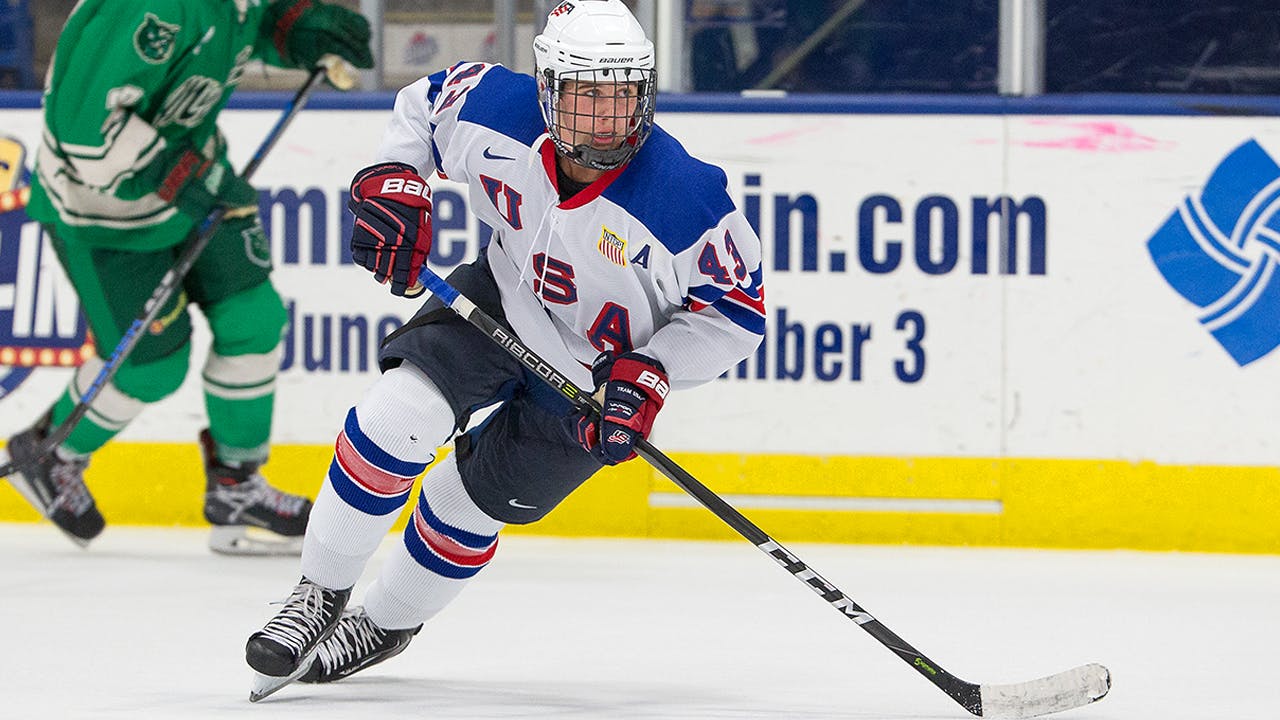
No. I won’t do this. Not again.
I won’t argue with you about which is more valuable: a top 5 draft pick or a taste of playoff experience. I won’t debate with you about whether tanking is something done by the players, the coaches or the General Manager. I will not, under any circumstances, discuss the matter of how to prevent becoming the Edmonton Oilers.
I’m sick of it. So are you. The debate is tiresome, frustrating, and always it involves sanctimonious invocations of who are the “true fans,” a concept so idiotic that it makes me want to get a new hobby that doesn’t have fans at all. Like chess, or fishing, or prog rock.
So let’s just fix it. I want to fix the whole stupid system. I want to eliminate the debate by changing the structure of how draft order is determined.
What if I told you I could offer your team a chance at a top 5 draft pick AND valuable playoff experience, while eliminating the incentive to tank? You’d say I was selling snake oil and you would be right. But I can give you something pretty close. Pull out your notebooks and sharpen your pencils: class is in session.
The Lottery
First off, look, there’s no solution that is ever going to completely solve the fundamental problem in a situation like this. That fundamental problem is that if you want to give the weakest teams a chance to improve, you have to give them the best shot at landing a superstar in the draft. But as long as you are rewarding failure, there will be some incentive to tank for those rewards.
The lottery system is an attempt to mitigate that problem by more or less randomizing the top 3 picks. The problem with this system is that it doesn’t eliminate the incentive to tank – you still guarantee yourself pick 4 if you finish in last place – and it sometimes gives ridiculous random rewards to teams that aren’t all that bad. Watching the Philadelphia Flyers jump from 13th to 2nd overall was a tough pill to swallow when they were a team that had only just missed the playoffs. But equally painful is the abysmal hockey that accompanies a legit tank: anyone who has watched last season Arizona Coyotes hockey can attest to this.
Maybe most important, the lottery takes something that is very significant to franchise development – the first round of the NHL draft – and makes it random. We complain about games settled by shootouts because they feel like a roll of the dice that does disservice to the 65 minutes of hockey that led up to it. But the lottery is worse, and seeing your team’s future determined by Bill Daly’s randomly-generated cue cards has to be one of the least compelling features of the modern NHL.
The presentation is awkward, it doesn’t make for exciting TV, and there are typically only 2 or 3 fanbases that emerge feeling good about what went down. My own experience is that Draft Lottery day has actually become one of my least-favourite days of the year, one I anticipate with dread and experience as disillusionment.
Remember Party of Five? That late-90s TV series about a family that just couldn’t catch a break? Mom and Dad die in a car accident, Charlie has cancer, Bailey is an alcoholic, and oh – are you still watching? – because Claudia just got sexually assaulted and Julia is hooked on narcotics. Every time you watched that show you just felt even more bummed out. That’s the draft lottery to me. Your season sucked and you’ve got very little hope, but maybe you’ll win the draft lottery… hahaha no you won’t, just kidding, why don’t you go sit in the corner and punch yourself in the crotch? No? Fine, Bill will do it while Gary laughs maniacally in the background.
Enough is enough. Let’s put the draft lottery in the scrap heap next to the glowing puck, the neutral zone trap, and the left-wing lock. (Although I’m saving that last one as a slogan in case I ever run for political office.)
The Basics
Ok, here’s my idea.
The short version: instead of a lottery, the order of the top 8 picks will be determined by a post-season tournament. Tanking will be discouraged because you’ll want your team to be playing good hockey at the end of the season so that you win the tourney and secure a higher draft position. But the misery of seeing a good team leapfrog a weak team in the lottery will be eliminated because the most any team can jump or fall is 3 positions. And if you do drop 3 positions in the draft, it won’t feel like cruel fate, because your team had a chance to earn a better draft pick on the ice.
Meaningful hockey in April for the league’s worst teams. High pressure games that give players a taste of what playoff hockey feels like, with local markets buzzing. No more cheering against your team to earn a better draft position; now you can cheer for them. Instead of #loseforhughes its #smackforjack like, heck yeah, we’re going to smack these other teams, you get the idea. Might need to work on the hashtag.
The tourney can be completed over six days, in between the final regular season games and the first playoff games. This will give a short breather for playoff teams to prepare, and will mean that the tourney won’t compete with the playoffs for the spotlight. It will be like an appetizer, a chance for the weaker markets to feel a bit of that playoff excitement, sell some tickets, see their players under pressure, and then end the season knowing precisely where they will fall in the draft.
So let me run through the details, then I will address some possible problems, then you can start tweeting at your local GM that this is the way forward.
The Tourney
Let’s take a hypothetical season and look at how it would work. I’ve used the final standings from 2016-17 and added Seattle into the mix, since we will be doing this in a 32-team league. (Yes, that’s a proposed Seattle Kraken logo, because who doesn’t want to hear Liam Neeson’s voice saying “release the kraken” while the players skate onto the ice through a giant sea monster?) Here’s the final regular season standings I will be using:
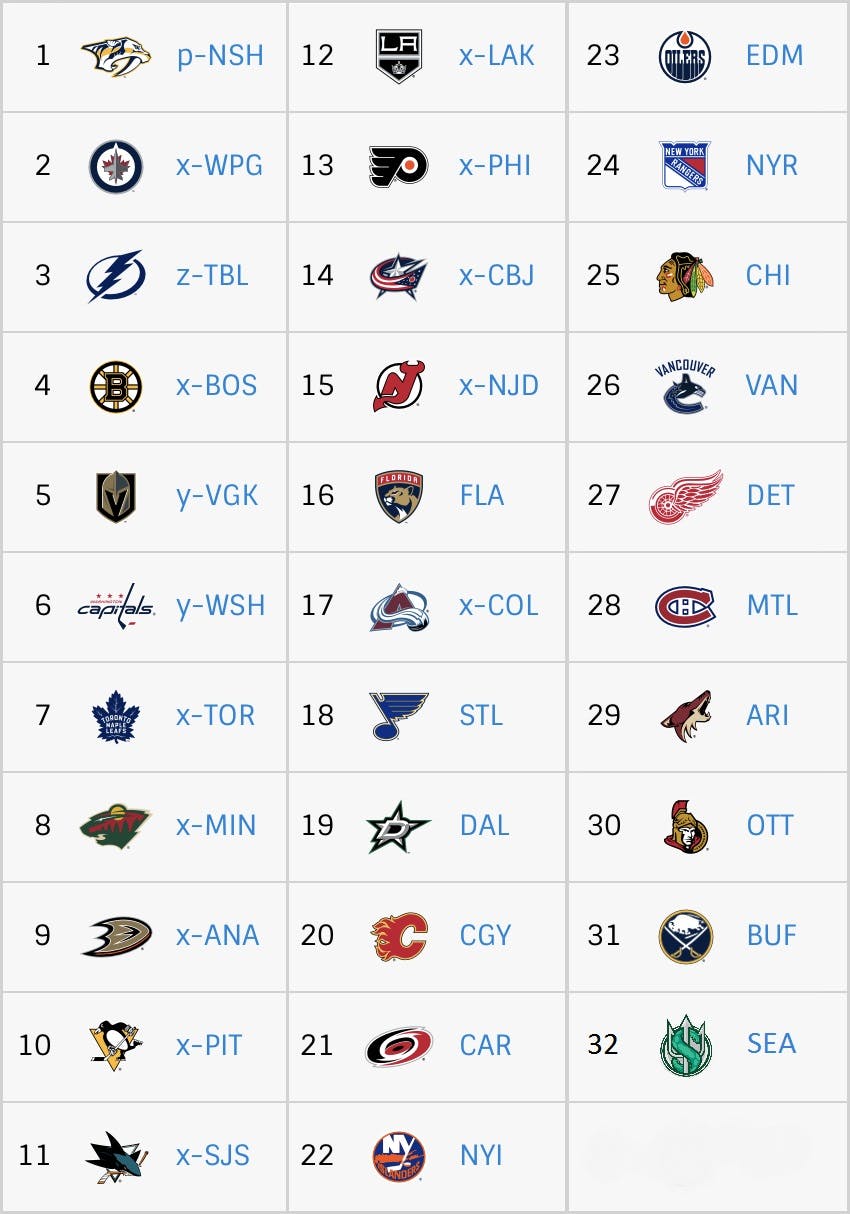
As usual, the 16 playoff teams will slot into the 17-32 picks, so no change there. Of the remaining 16 teams, the top 8 will simply draft in reverse order of where they finished in the standings, in slots 9-16. So far, pretty simple, pretty fair. These are typically teams that were competing for a playoff spot, so it’s unlikely that they are desperate for a generational draft pick, and it would be ridiculous for one of them to jump into the top picks.
So, based on the standings for the bottom-16 teams, here’s how the top 16 draft picks look so far:
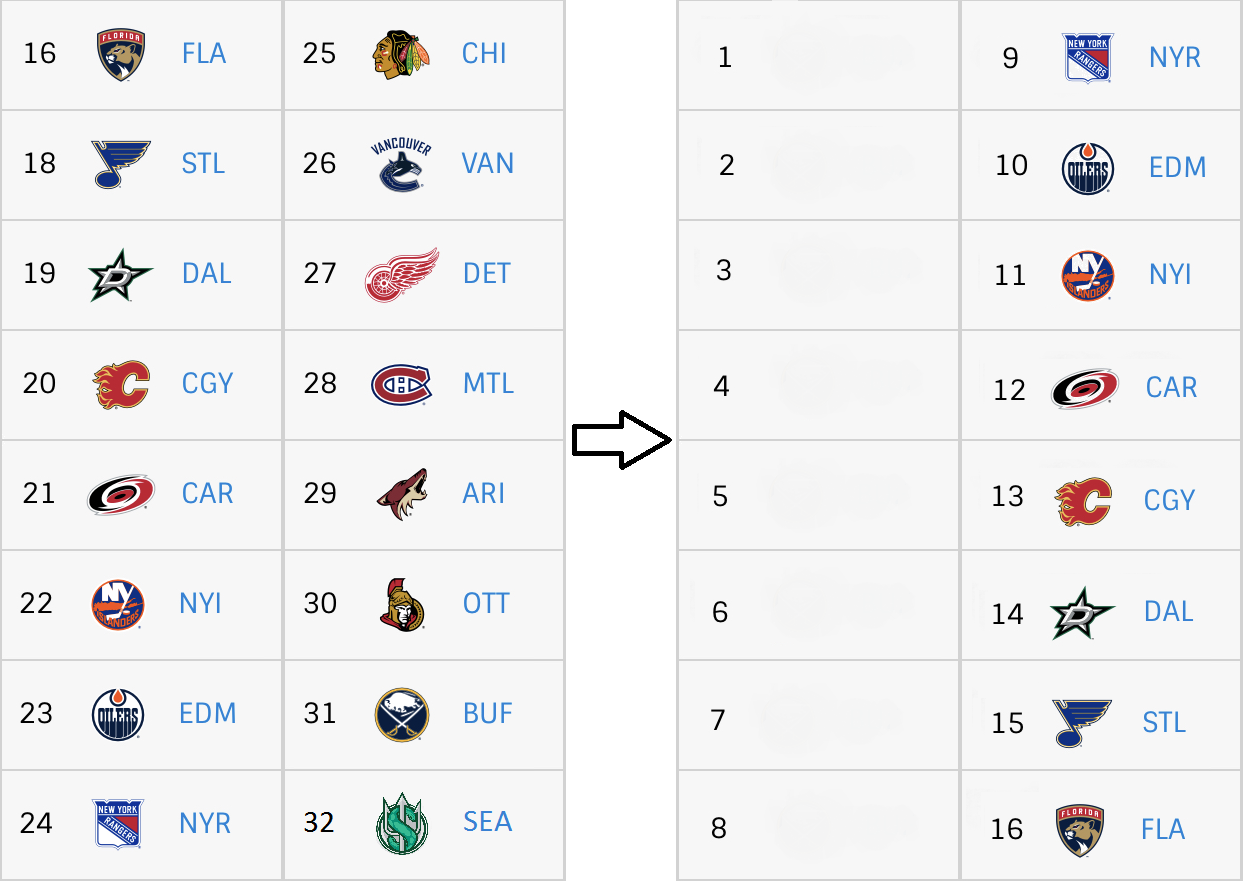
Ok here’s where it gets fun. The teams that finished 25th, 26th, 27th, and 28th overall play a round-robin tourney to determine the #5, #6, #7, and #8 draft position. Meanwhile, the four worst teams play a round-robin tourney to determine the top four draft positions.
So let’s start with the 25th-28th place teams. In the example I’m using, they were Chicago, Vancouver, Detroit, and Montreal. Each team plays each team, with one day in between games. (The other tourney, featuring the 29th-32nd place teams, will play on the off days, so that each of these six nights there will be 3 games.) Home-ice advantage goes to the team with the higher finish, so Chicago would play all its games at home.
The results of the 25th-28th place round-robin will determine the order of picks 5-8. In the event of a tie in two teams’ record, the tie is broken by goal differential. In the unlikely event that goal differential in the tourney is also tied, then the tie is broken by regular season standings.
So let’s say in our example that the Canucks elevate their game, Bo Horvat proves he has playoff jam, Alex Edler draws from his postseason experience and the Canucks win out the tourney, beating even their old rivals in Chicago. Vancouver jumps to 5th overall pick. Meanwhile, Chicago had sold at the deadline and played very poorly down the stretch to drop down in the standings, came into the tourney on its back foot, got beaten in every game and finished last. Chicago drops to 8th overall pick. Here’s how it looks:
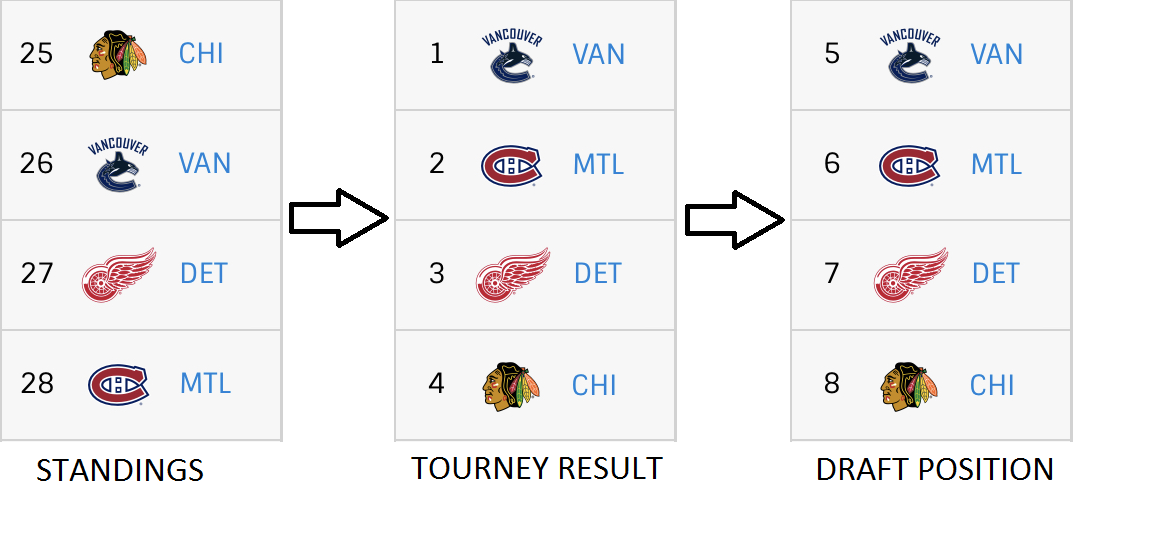
We can now update the top 16 draft picks by adding these four to the mix:
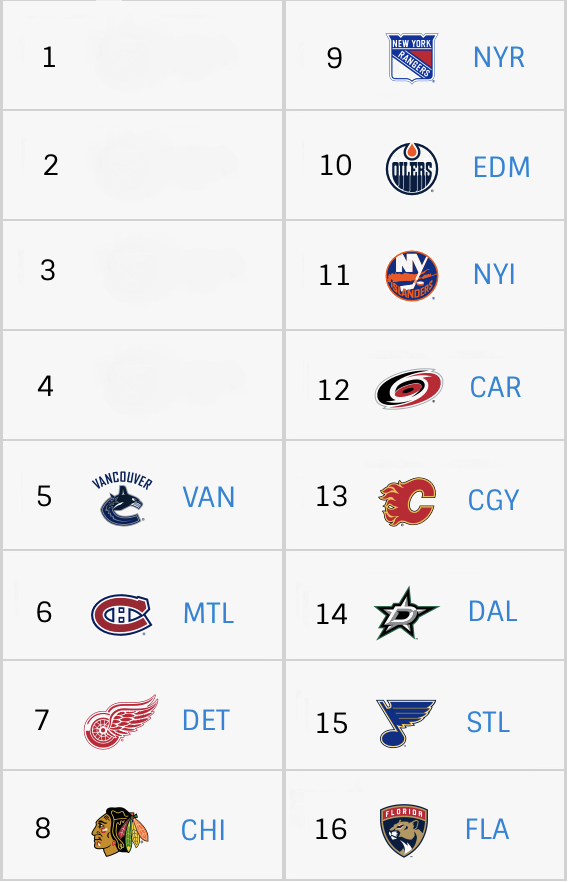
Meanwhile, over in the consolation derby, four bad teams are in a dogfight to land the top overall pick. This year the standout player is Jack Hughes and while he might not be a Connor McDavid, he could certainly be a franchise-altering addition. What player wouldn’t want to add a player like Jack Hughes, knowing how much it could change the fortune of your team? Hockey players want to win, and these players know that adding a blue-chip prospect is going to help you win, maybe as soon as next season. These games will have some bite.
Let’s be honest, you have to really suck to finish in the bottom-4. These are bad teams, they deserve a chance at a potential best-player-in-the-world. Prior to the draft lottery system, such a player would be handed to the worst team on a sliver platter, and you ruined that for everybody, Edmonton. But since the draft lottery started, some of the worst teams have been repeatedly robbed of the generational talent they needed, as better teams have jumped ahead of them by the luck of the draw.
Under my system, the four worst teams will each get a very good player. But they also each have a chance to get an elite or generational player. This tourney means something and it is not out of reach for any of these teams to beat one another. It may well be the best hockey any of these markets see all year, and perhaps most importantly, it’s an opportunity for teams to preach hope to their fans and for players to get the kind of encouragement they deserve. Players stuck on bad teams often talk about that grind, having dispassionate or angry fans, feeling the pressure of wanting to deliver but being unable to. Here you go: three games to show the fans you’re in it to win it. Time to deliver.
Ok, back to our hypothetical, the tourney goes ahead, and Buffalo rewards its long-suffering fans with a knockout performance punctuated by a win over Arizona in the final game of the tourney to secure the #1 overall draft pick. Ottawa drops two spots and Pierre Dorion assures fans that Ottawa is, in fact, still a team. Drama in four markets that might not have expected any excitement that spring.
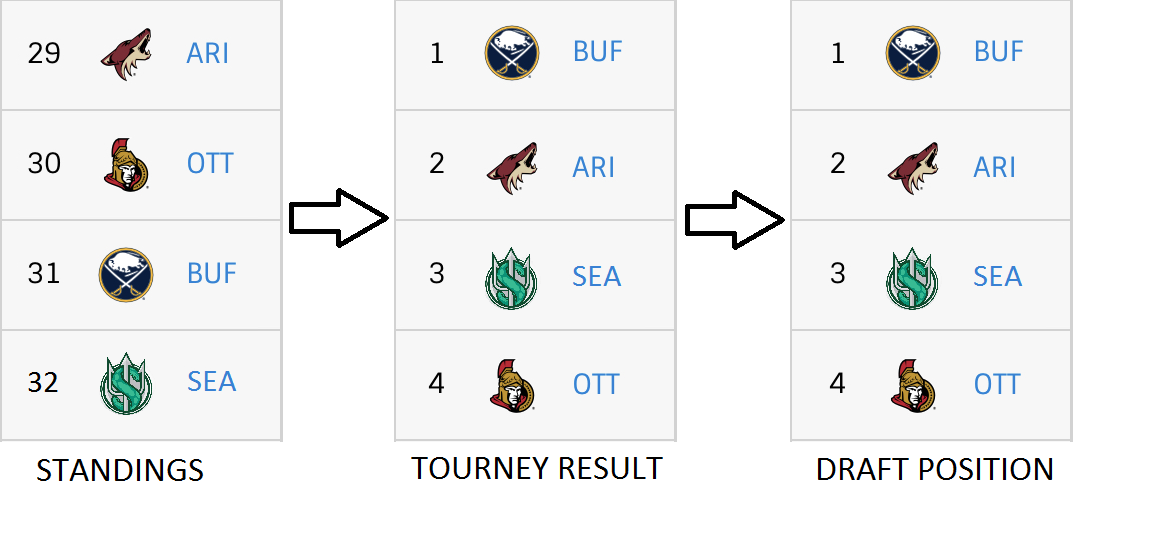
For eight hockey towns, the end of the season has just been far more interesting than it used to be. Sports radio ratings are up, merchandise and ticket sales get a boost, and fans have a reason to care.
That’s all we really ask for out of sports viewership, isn’t it? We invest ourselves in these franchises so that we can forget about the daily grind of life, family, a job, and the generally dismal prospects offered to working people in the 21st century. We dig into it because we want to feel something. We want to experience the emotional ride of caring about something, being part of a community that cares about that same thing, and sticking together through the highs and the lows. To care, and to lose, hurts. But better to have loved and lost than to feel nothing at all.
Ok, your therapy session is over, and here’s how our new post-season tourney system has shaped the draft order:
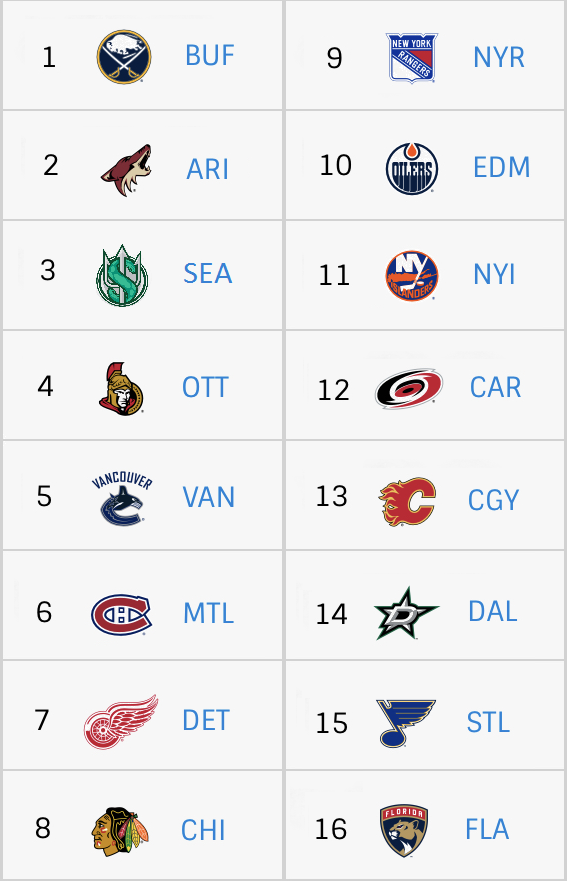
Can anyone claim it wasn’t fair? The better teams draft where they fell in the standings. The weaker teams had a chance to improve their position but nobody dropped way beyond where they should have. No one can accuse the NHL of gaming the lottery system. No one can hate Edmonton for getting the #1 pick because they will have to win a tournament to get it. We’ve all had some fun. Now we can fade into the night and forget about these bad teams for awhile, and settle in for the real playoffs.
What Could Go Wrong?
I’ve kicked this idea around a lot in the past few years and I’ve heard some objections. I’ll try to anticipate and address them here. As I said at the top, this isn’t perfect, and I’m not sure any system will be. But this is a heck of a lot better than the draft lottery as it currently operates.
Is it gimmicky? Sure, maybe a little. But so is 3-on-3 overtime and it has quickly become one of my favourite things about regular season hockey.
Is it too much hockey? It’s only three extra games, and I don’t see any of the playoff teams complaining about the extra hockey. This is increased revenue for the owners, especially if they get home games… and that means even less incentive to tank since home-ice advantage goes to the teams with better records. If we are really worried about too many games, let’s reduce the regular season by a game or two to balance it out.
Will it detract attention from the playoffs? I don’t think so. The tourneys will happen before the playoffs start, so eight markets will be focused on that, but I doubt that the radio discussions in playoff-bound Toronto are going to be unduly distracted by the battle between Buffalo and Arizona for 1st overall pick. For playoff markets, it will be a bit of extra spice in the days leading up the playoffs. But for those bottom-8 teams, it will be the climax of the season. Worth it, I think.
Will pending free agents care about the tourney? Maybe not as much as players who know they’re sticking around, but the same can be said of game 82. Or game 81. Or game 80. At least in this case, there will be extra attention from fans, media, and scouts who want to see how a player performs under some pressure. Looking to sign a big new contract over the summer? Pop a few goals in a game that matters and watch those dollar signs drop.
More importantly, though, there will be pressure from within the locker room to bring your A game. Suppose Chris Tanev is on an expiring contract and doesn’t expect to be re-signed in the offseason. Do you really believe he will half-ass a game that matters a huge amount to Bo Horvat, Brock Boeser, Ben Hutton and Troy Stecher? I think you can count on the Tanman, pending UFA or not.
Someone once scoffed at this idea because they believed you would never convince a mediocre third-line player to try to win a tournament to draft their replacement. Really though? Suppose the Canucks can’t trade Brandon Sutter. It’s tourney time and the prize is Jack Hughes. You really think Sutter decides to phone it in? You don’t think his coaches and teammates will notice? You don’t think that hastens his being bumped down the depth chart? I think Sutter goes out there and plays his best hockey to try to prove to the coaching staff that he’s still a key piece of this team and if they draft Jack Hughes, some other bubble player – not Captain Clutch in last year’s tourney – is losing their spot.
Will it eliminate tanking? I’m not sure there is any way to eliminate the possibility of a tank unless you move to a totally random draft system, and if you do that, teams that are in the gutter might stay there forever. So yeah, you might still have some tank instinct. Maybe a team tries to lose some games down the stretch in order to drop into the 25-28 tourney, hoping they can turn it on and beat those teams to lock down a top-5 pick.
But that’s going to be a risky play, because hockey isn’t a sport where you can easily turn it on and turn it off. If a coach goes as far as to, say, ride the backup goalie down the stretch to lose some games, is there any guarantee that the starter steps in and wins three crucial games at the end? That’s not how hockey works. A team that is battling right to the end is likely to be sharper and in a better position to win those games in the tourney. And if you blow it, then all you’ve accomplished by tanking is an 8th overall pick. Not a great look.
Furthermore, it would be easy enough to set up some rules to mitigate the problem; for instance, to be eligible to play in the tourney, a player would have to have played in, say, 14 of the last 20 games. This would prevent a team from shutting down its best players and then bringing them back for the tourney. Again, though, it isn’t at all clear to me that doing so would be effective anyway.
As far as I can see it, this system would incentivize even the weakest teams to try to play good hockey down the stretch so that they could go into that tourney, impress their fans, and give themselves an opportunity at landing a great teammate who could help turn the franchise around and get them where they really want to be, which is competing for the playoffs or a Stanley Cup.
Tweet Your GM
Come on, let’s give this a try. It gives the players and fans meaningful hockey right down to the end of the season. It gives the organizations a chance to evaluate their players in higher-stakes games while also cashing in on an event that would generate excitement and interest. It mostly eliminates the painful “tank vs playoffs” debate by taking away much of the incentive to tank.
And it totally eliminates the horrible and aggravating draft lottery system which leaves nearly nobody satisfied or entertained.
Suppose the Canucks drop 8 of their next 10 games. It’s a very plausible scenario and it would all but end discussions of a playoff run this year. Maybe Jim does right by us and manages to trade some vets for picks and prospects. But instead of another death march to April, game after meaningless game with little reason to pay attention, we would be talking about which bracket we might fall to and who we would be playing. We’d be gearing up to see whether Elias Pettersson has another level come post-season. We’d be talking about whether it is a good idea to get Quinn Hughes up in time that he would be eligible to play in the tourney that could determine whether his brother Jack wears Canucks colours.
Are you kidding me? I’m jacked just thinking about it.
In fact, I’ve got the hashtag ready now: #getjackedforjack
Recent articles from Tyler Shipley





